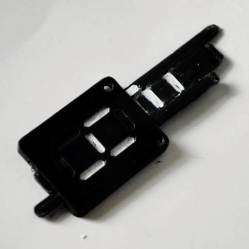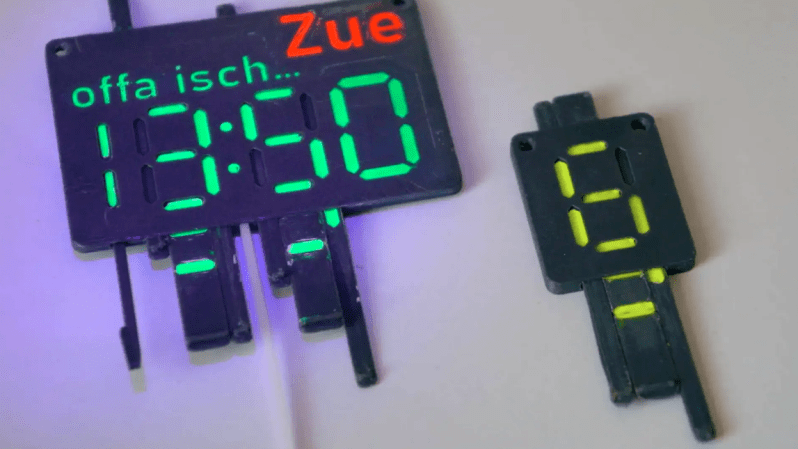We’ve seen a lot of clever re-imagining of the classic 7-segment display, and proving there is still room for something new is [Jack]’s 7-segment “DigiTag” display.
 This 3D printable device has a frame into which is slotted three sliders. These sliders can be adjusted individually, mixing and matching the visibility of colored and uncolored areas, to create digits 0-9. We’ve seen some unusual 7-segment-inspired displays before, using from one motor for the whole digit to ones that need one motor per segment, but nothing quite like this approach.
This 3D printable device has a frame into which is slotted three sliders. These sliders can be adjusted individually, mixing and matching the visibility of colored and uncolored areas, to create digits 0-9. We’ve seen some unusual 7-segment-inspired displays before, using from one motor for the whole digit to ones that need one motor per segment, but nothing quite like this approach.
While this particular design relies on the user to manually “dial in” each digit, the resulting key-like assembly (and unique shape for each digit) seems like it could have some interesting applications — a puzzle box design comes to mind.
If you have any ideas of your own on how this could be used, don’t keep them to yourself! Let us know in the comments, below.

















Looks like each digit is dialed in by adjusting the height of 3 rods. Think of them as pins in a lock. You could build a “key” that slides into a cylinder full of these pins and displays a specific series of digits (or even letters) above.
I’m sort of at a loss for a good use case though.
For entertainment, it would be interested to have an escape room where you find a physical key, and sliding it into this “lock” displays a short word or sentence which is your hint to find the next key, which you slide into the lock to display the next hint word…
I have a 5-digit keypad password on my garage that I can never remember. It would be kind of funny to carry around a key which I can insert to this display to reveal the correct password which I then manually type into the key pad.
Or you could write the ‘word’ onto a key fob… :)
For a mechanical approach, it seems like a peculiar cam shaft could be used move each slider into the correct place. However, an electromechanical approach to shift them using rudimentary linear motors which would be neat and not too complex.
I don’t think the current design will survive too many switches as friction will wear them down. Perhaps embedding small bearing would help improve their longevity.
Good idea.
Oddly, seven-segment displays were invented over 100 years ago.
https://en.wikipedia.org/wiki/Seven-segment_display
Now, if you replaced those 3D printed rods with lengths of printed transparency film, you could actually reduce the vertical height needed.
Add some sprockets, and a motor could drive the individual segments.
Use 35mm film, which already has the sprocket holes. Also allows different colours plus backlighting is possible.
Possibility tweaking the design so instead of rods there is a wheel might mak it easier to control…
If you slanted/italicized the digits you could stack 0-9 sequentially and compactly on a single slider instead of using three separate sliders.
I like this idea, but make 4 sliders instead of 3, and have those slides be binary in their position. Tiny solenoids or perhaps memory wire could drive them. You then ‘may’ have room for a few more characters.
Mechanical 7-segment display with 3 sliders (rotors) is used to make the following clocks driven by only one motor,
https://www.youtube.com/watch?v=_ycXX235-Vc
https://www.youtube.com/watch?v=Iom0Bg0sHtQ
and the original idea is came from
https://www.youtube.com/watch?v=O9Ha6cM0RjI
This project inspired me to make a nearly useless numerical input system using the same principle. See https://hackaday.io/project/188053-nearly-useless-numerical-input-system